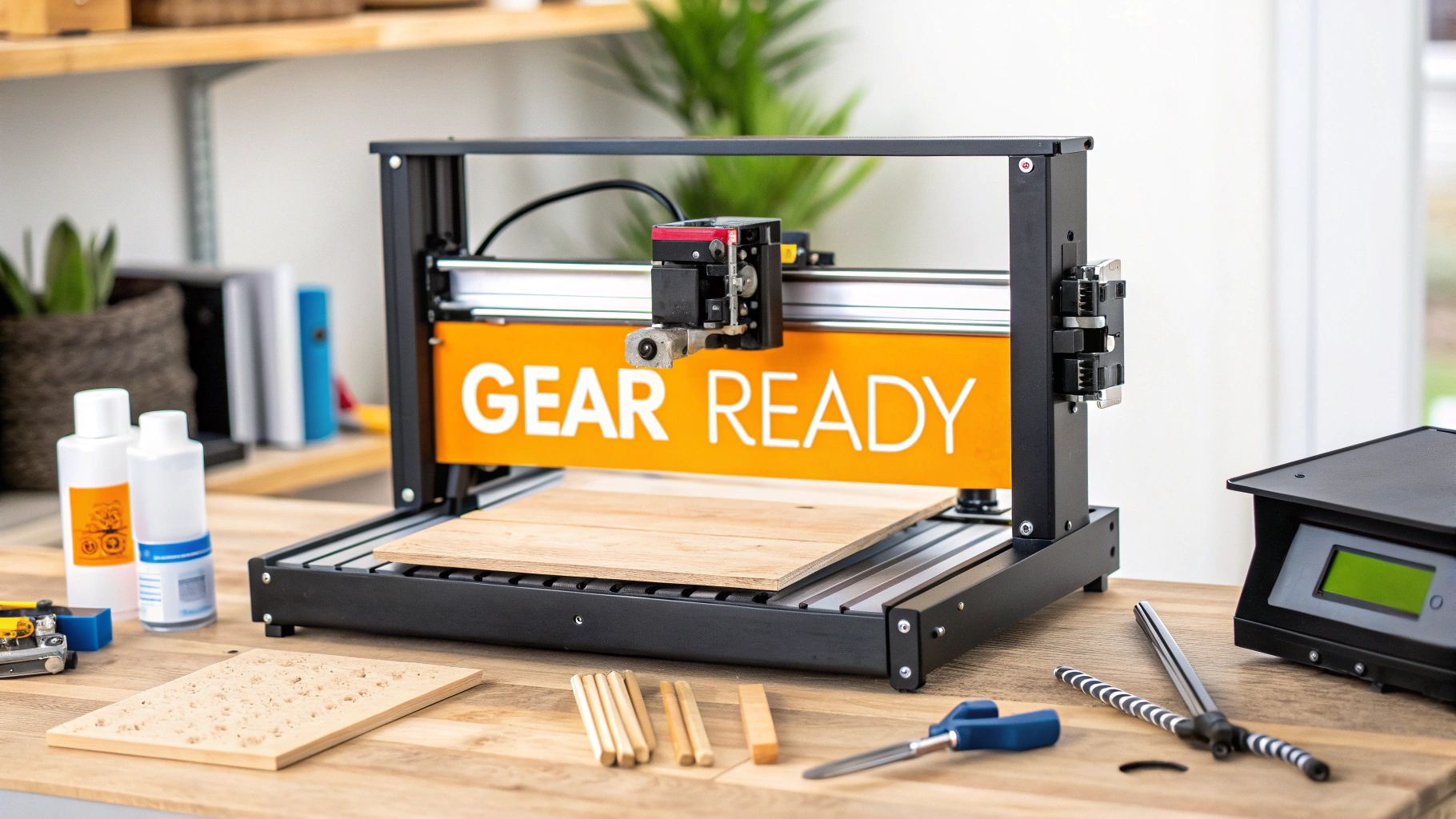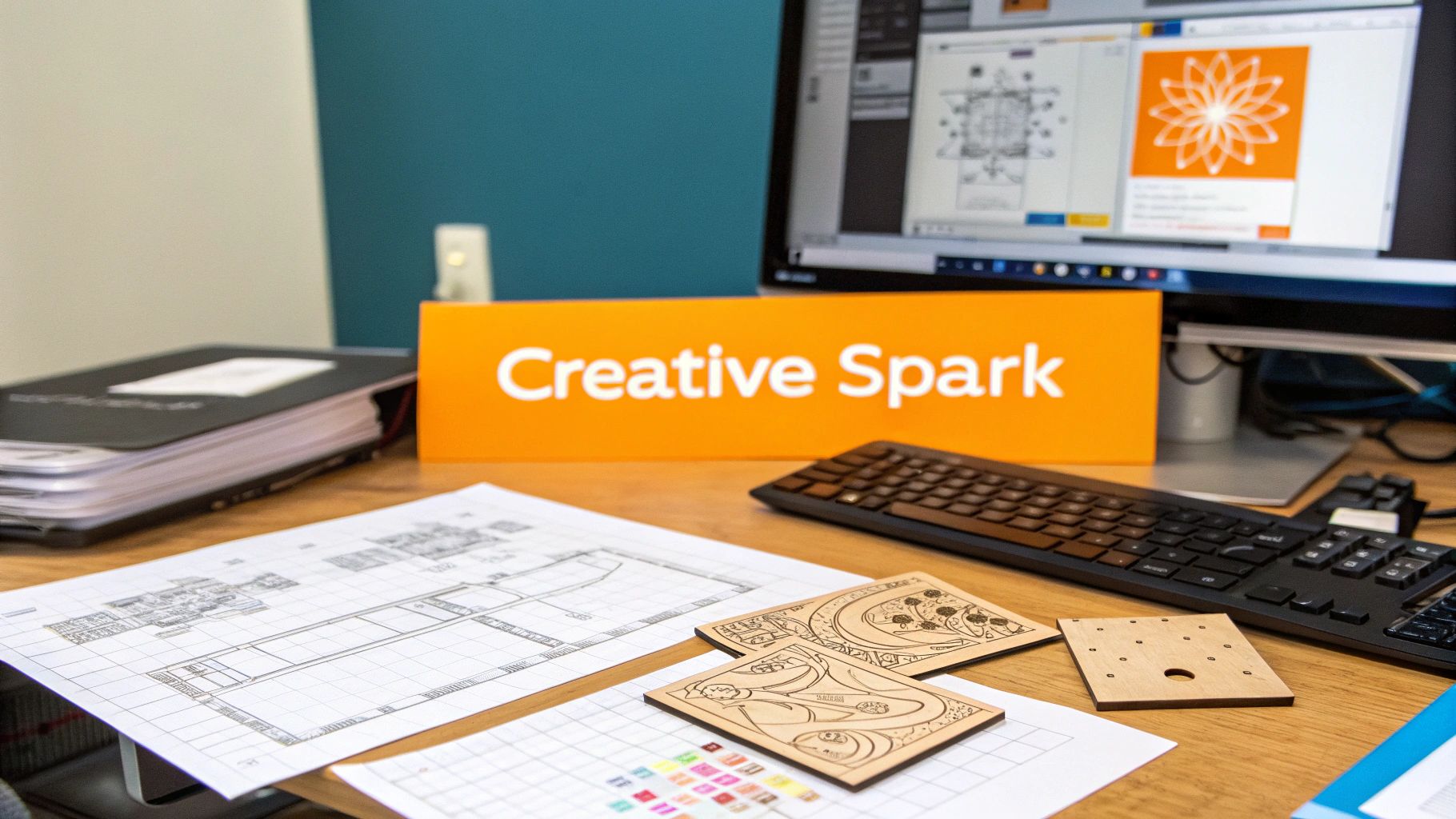Why Starting a Laser Engraving Business Is Your Next Brilliant Move

The laser engraving industry is brimming with potential. Now, more than ever, consumers are seeking personalized items, driving a significant demand for unique, custom-made products. This growing personalization culture, coupled with increasingly accessible technology, makes venturing into laser engraving an appealing business opportunity.
Consider the current consumer shift toward bespoke gifts and personalized items. This trend fuels demand across various markets, from weddings and corporate giveaways to pet accessories and home décor. Even within competitive markets, specialized engraving services are thriving by catering to these niche desires.
The accessibility of laser engraving technology has also dramatically improved. Equipment that was once prohibitively expensive and complex is now available in affordable, user-friendly options. This makes it easier than ever to acquire the tools needed to start.
This increased demand and accessibility create a strong foundation for business growth. This potential is mirrored in current market statistics.
Market Growth and Projections
The laser engraver market, valued at approximately $2.9 billion in 2024, is projected to reach $5.86 billion by 2031. This represents a CAGR of 9.2%. This impressive growth underscores the potential for businesses focused on customized products. Industries like automotive, aerospace, and electronics also utilize laser engravers for component marking, further bolstering demand for these services. Learn more about the projected market growth from Fortune Business Insights.
Equipment Selection: Making Smart Investments From Day One

Choosing the right laser engraver is a crucial first step when starting a laser engraving business. This key investment will impact your production capabilities, the range of materials you can process, and your overall profitability. While budget-friendly options or top-of-the-line machines might seem appealing, finding a balance is essential.
Finding the Sweet Spot: Balancing Cost and Capability
A diode laser is often recommended for entrepreneurs just beginning their laser engraving journey. These lasers offer a more affordable entry point and effectively engrave common materials like wood, acrylic, and leather. This allows you to gain valuable experience and build your customer base without overspending.
As your business expands and you're ready to work with different materials, such as metal, upgrading to a CO2 laser or a fiber laser makes sense. This phased approach to investment minimizes initial financial risk while providing a path for future growth.
Beyond Watts: Key Considerations for Laser Engravers
While wattage is a factor to consider, affecting cutting speed and depth, other specifications are equally important. Software compatibility, for instance, significantly impacts your workflow. User-friendly software with robust design capabilities streamlines the engraving process and unlocks greater customization options.
Service agreements and warranty options are also vital. Equipment downtime can be expensive, so a solid service agreement minimizes disruptions and ensures your equipment receives proper maintenance. For more insights, check out our article on optimizing your laser engraving workflow.
Future-Proofing Your Investment
Think about the long-term potential of your chosen laser engraver. Can it be upgraded with new features or more powerful components down the line? This adaptability can lead to significant cost savings compared to replacing the entire system later on.
Complementary Equipment and Workspace Setup
Beyond the engraver itself, other equipment is essential for a smooth operation. A ventilation system is crucial for removing fumes and particles produced during engraving, protecting your health and equipment. Laser safety glasses are also a must-have to protect your eyes.
Finally, consider your workspace layout. A well-organized space boosts efficiency and workflow. As your business grows, dedicated areas for material storage, production, and finishing become invaluable, enabling smoother operations and potential expansion.
To help you choose the right laser engraver, take a look at the comparison table below:
Laser Engraver Comparison by Type: This table compares different types of laser engravers by cost, capabilities, and ideal applications to help you find the best fit for your business.
| Laser Type | Price Range | Material Compatibility | Ideal Applications | Maintenance Costs |
|---|---|---|---|---|
| Diode Laser | $200 - $1,500 | Wood, Acrylic, Leather, Anodized Aluminum | Hobbyists, Small Businesses, Engraving Soft Materials | Low |
| CO2 Laser | $1,500 - $10,000 | Wood, Acrylic, Leather, Fabric, Glass, Some Plastics | Small to Medium Businesses, Higher Power Engraving/Cutting | Moderate |
| Fiber Laser | $4,000 - $50,000+ | Metal, Plastic, Coated Metals | Industrial Applications, High-Precision Metal Marking/Engraving | High |
Key takeaway: Diode lasers are a good starting point for beginners due to their lower cost and ease of use. CO2 lasers offer increased power and material versatility for growing businesses. Fiber lasers are best suited for industrial applications and metal engraving due to their high precision and power.
Finding Your Perfect Niche: Where Passion Meets Profit

Generic laser engraving services often face a lot of competition. Finding the right niche, a specialized area within the broader market, is key to your success. This means identifying underserved markets that also align with your skills and passions.
This focused approach allows you to develop deep expertise and truly understand your target customer's specific needs.
Identifying Profitable Niches
Successful laser engravers often find surprisingly profitable niches. Some specialize in heritage preservation, restoring antique furniture or recreating historical artifacts.
Others might focus on specialized industrial marking, engraving intricate designs or serial numbers onto machinery. Still others cater to the luxury customization market, personalizing high-end goods.
These specialized services often come with higher profit margins than generic engraving. Think about the difference between engraving a standard phone case and a custom-designed, handcrafted wooden box. The specialized item has a much higher perceived value, justifying a premium price.
Factors driving the growth of laser engraving businesses include the increasing demand for personalized products and the continued expansion of e-commerce. The global laser engraver market is projected to grow at a CAGR of 9.2% between 2024 and 2031, highlighting the significant potential for business expansion. The e-commerce boom has further fueled demand for customized promotional items and packaging, often created with laser engraving. More detailed statistics can be found here: Verified Market Research.
Testing Market Demand and Identifying Opportunities
Before fully committing to a niche, it's essential to test market demand. Conduct surveys, attend craft fairs, or create sample products to gauge customer interest.
This real-world feedback helps you refine your offerings and confirm that there’s a viable market for your specialized services.
Also, explore complementary service opportunities. If you specialize in laser-engraved pet tags, for instance, consider branching out to personalized pet collars or leashes. These additions can increase your average order value and build a stronger brand identity within your chosen niche.
Positioning for Success
Strategic positioning is about finding that sweet spot: a niche with limited competition but high demand. This maximizes your chances of attracting customers and building a strong presence in the market.
This often involves analyzing existing businesses, identifying gaps, and targeting underserved customer segments.
When evaluating potential niches, consider growth potential, barriers to entry, and how well the niche aligns with your skills. A niche with high growth and low barriers to entry offers a favorable environment for business development.
Just as important is choosing a niche that truly interests you. Passion fuels dedication and contributes to long-term success. It shows in the quality of your work and how you engage with your customers, which ultimately helps build a sustainable business.
Creating Your Business Blueprint: From Vision to Execution

A successful laser engraving business needs more than just artistic skill and the right tools. It requires a robust business blueprint to guide you from concept to consistent profits. This involves thinking about your business's legal structure, financial projections, and operational strategies.
Structuring Your Business For Success
Choosing the right business structure is essential for legal protection and tax benefits. Many laser engraving businesses begin as sole proprietorships because of the simplicity.
However, as your business expands, incorporating as an LLC or S-corp provides greater liability protection. This safeguards your personal assets from business debts.
Consulting with a business attorney or tax advisor can help you decide on the most beneficial structure for your specific needs. They can also guide you through registration, licensing, and compliance with local regulations.
Location, Insurance, and Regulatory Compliance
Your business location significantly impacts operating costs and your potential customer base. Working from home offers cost savings. However, a dedicated workshop or retail space increases visibility and can attract more customers.
Consider factors like accessibility, zoning regulations, and proximity to your target market when choosing a location.
Insurance is another crucial element. General liability insurance protects you from financial losses due to accidents or property damage. Product liability insurance protects you if a customer is harmed by one of your engraved products.
Laser operations have specific regulatory requirements concerning safety and ventilation. Research these requirements early to ensure a safe and compliant workspace from the beginning. This proactive approach helps avoid potential fines or delays down the road.
Financial Projections and Cash Flow Management
Creating realistic financial projections is vital for long-term success. Estimate your startup costs, including equipment, materials, marketing, and operating expenses. Then project your revenue based on your niche, pricing strategy, and expected sales volume. It's common for new engraving businesses to underestimate initial expenses and overestimate early revenue.
Cash flow management is also essential, particularly in the early stages. Track your income and expenses diligently and establish a financial safety net for slower periods, such as seasonal downturns.
Pricing Strategies and Metrics That Matter
Your pricing should strike a balance between competitiveness and profitability. Research competitor pricing and look for opportunities to differentiate yourself through value-added services. For instance, offering rush orders, personalized design consultations, or premium packaging can justify higher prices.
Track metrics that directly contribute to growth, like customer acquisition cost, conversion rates, and customer lifetime value. These provide more useful information than vanity metrics like social media followers.
To better understand typical expenses, review the sample table below:
The following table outlines realistic monthly expenses for small, medium, and large laser engraving operations to help with accurate business planning.
Sample Monthly Expense Breakdown for a Laser Engraving Business
| Expense Category | Small Operation | Medium Operation | Large Operation | Notes |
|---|---|---|---|---|
| Rent/Utilities | $0 - $500 | $500 - $1,500 | $1,500+ | Home-based vs. dedicated space |
| Materials | $100 - $500 | $500 - $2,000 | $2,000+ | Depends on volume and material type |
| Marketing/Advertising | $50 - $200 | $200 - $1,000 | $1,000+ | Online and offline promotion |
| Software/Subscriptions | $20 - $100 | $100 - $300 | $300+ | Design software, business tools |
| Insurance | $50 - $150 | $150 - $400 | $400+ | Liability, product liability |
| Maintenance/Repairs | $50 - $200 | $200 - $500 | $500+ | Equipment upkeep |
As you can see, the expenses can vary significantly depending on the size and scope of your operation. Planning accordingly is key to profitability.
By developing a thorough business blueprint, you establish the foundation for a thriving and sustainable laser engraving business. This proactive planning helps you navigate challenges, capitalize on opportunities, and reach your long-term goals. Next, we'll discuss effective marketing strategies and building a loyal customer base.
Marketing That Connects: Building Your Client Pipeline
Running a successful laser engraving business takes more than just technical skill. It requires a solid marketing strategy to connect with potential clients. Building a client pipeline means consistently attracting and converting leads into paying customers. This involves showcasing your unique skills and the value you bring to the table.
Showcasing Your Visual Story: The Power of Imagery
Laser engraving is a visual art form. Leverage this by showcasing your work on image-centric platforms. High-quality photos and videos of your finished products are crucial for grabbing attention. Consider platforms like Instagram and Pinterest where visual content thrives.
Creating engaging content goes beyond simply posting pictures. Educate potential clients about the possibilities of laser engraving. Show them how a plain wooden box can become a personalized keepsake. Highlighting unique applications can inspire customers to envision projects they hadn't considered before. Before-and-after photos are especially effective.
Building a Portfolio That Sells
Your portfolio is a key sales tool. It shouldn't just be a collection of your work, but a curated display of your best and most diverse projects. Organize your portfolio by material or application. This makes it easy for potential clients to find what they're looking for. For example, if you specialize in wood engraving, create a dedicated wood projects section.
Include detailed descriptions for each project. Highlight the materials, techniques, and the final product's impact. This adds professionalism and showcases your expertise.
Networking and Referrals: The Power of Partnerships
Building relationships with complementary businesses can be a fantastic source of referrals. If you engrave wedding gifts, connect with wedding planners or florists. These partnerships can generate a steady stream of new clients. This collaborative approach benefits both parties and expands your reach within your target market.
Digital and In-Person Marketing: Reaching Your Audience
A well-rounded marketing strategy uses both digital and in-person tactics. Digital marketing, like social media and Search Engine Optimization (SEO), helps reach a broader audience. In-person marketing, such as attending craft fairs or networking events, allows for direct interaction with customers. This combined approach increases your chances of connecting with the right clients.
Focus on generating qualified leads—people actively looking for laser engraving services. For instance, targeting keywords related to "custom laser engraved gifts" can attract potential clients. You might also like: Our collection of blog posts.
Demonstrating Value: Beyond the Surface
Clearly communicating the value of your services is crucial. This means going beyond just stating your prices. Emphasize the quality, craftsmanship, and personalized touch you offer. Explain how your services solve a problem or meet a specific need, like creating unique gifts, branding company merchandise, or personalizing everyday items.
By using these marketing strategies, you can effectively build your client pipeline, create a strong brand, and achieve long-term success in your laser engraving business.
Scaling Beyond The Startup Phase: Pathways To Growth
Starting a laser engraving business is exciting. But true success lies in scaling beyond that initial startup phase. This means strategically expanding your operations to increase profits and reach a wider audience. But how do you navigate the various paths to growth?
Employees Vs. Automation: Balancing Your Resources
One of the first decisions you’ll face is choosing between hiring employees and investing in automation. For boutique studios focused on highly customized pieces, skilled employees are essential. Their craftsmanship and attention to detail allow for premium pricing.
However, for volume-focused operations, automation can significantly boost output and lower labor costs. This allows you to compete on price and handle larger orders efficiently. Finding the right balance between human skill and technology is key to sustainable scaling.
Specialization Vs. Expansion: Defining Your Market
Another crucial decision involves choosing between specializing and expanding the services you offer. Specialization allows you to develop expertise in a specific niche, becoming the go-to provider. This focused approach often commands higher prices and attracts a loyal customer base.
Alternatively, expanding your services can attract a larger audience and diversify revenue streams. This strategy works well if you’re targeting varied markets. For example, offering laser engraving and cutting services can attract clients looking for a one-stop shop. You might find this helpful: Our resources on scaling your laser engraving business.
Strategic Facility Expansion: Justifying The Investment
Expanding your physical workspace is a major investment. It’s essential to evaluate if the potential return justifies the cost. If your current space limits production and hinders workflow, expansion becomes crucial for growth.
However, facility expansion should align with your business strategy. A smaller, specialized workspace might suffice if you're focusing on high-end, low-volume projects. High-volume operations, on the other hand, require more space for equipment, materials, and efficient production.
Building Recurring Revenue: Weathering Seasonal Fluctuations
Creating recurring revenue streams is essential for long-term stability, especially in industries with seasonal demand. One approach is establishing subscription services for regularly engraved items, like corporate gifts or pet tags. This provides consistent income and builds customer loyalty.
Partnering with businesses needing ongoing engraving services, like industrial marking or product customization, also creates predictable revenue. These partnerships can offset seasonal dips and ensure consistent cash flow.
Expanding Your Reach: Targeting New Markets
Expanding beyond local markets can unlock substantial growth. E-commerce platforms offer a cost-effective way to reach a global audience. However, it's important to balance expansion with capacity. Overextending your resources can impact quality and customer service.
Consider strategic partnerships with businesses in other regions. This allows you to enter new markets without the logistical challenges of managing remote operations.
The Asia-Pacific region currently dominates the global laser engraving machine market. The market is expected to grow from $2,900.84 million in 2022 to $6,186.62 million by 2030, with a CAGR of 9.93%. This growth suggests that starting or expanding a laser engraving business in regions with thriving manufacturing sectors can be profitable. More statistics can be found here: Zion Market Research.
Systematizing Your Operations: Maintaining Quality At Scale
As your business grows, systematizing operations becomes vital. Implementing standardized processes for order fulfillment, quality control, and customer service ensures consistent quality with increased output. Investing in project management software can streamline workflows and improve communication.
Different Trajectories: Finding Your Path To Success
There isn't one "right" way to scale a laser engraving business. Some businesses thrive as boutique studios, charging premium prices for custom creations. Others succeed through volume-focused operations using efficiency and automation. The key is to choose the path that aligns with your skills, resources, and target market.
Ready to take your business to the next level? Laser Insights China provides resources for navigating the laser industry. From expert interviews to technical guides and market analysis, Laser Insights China helps you make informed decisions and achieve sustainable growth. Visit today to unlock your business's full potential.

